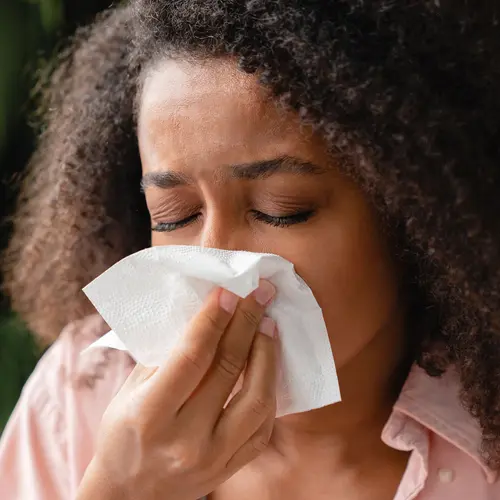Got allergies? Then you probably have questions. Here are answers to some of the most popular.
Can Allergies Be Cured?
You can’t cure allergies, but you can treat and control the symptoms. It may take a little work. You’ll need to make a few changes to your surroundings or figure out how to stay away from things that trigger allergy attacks.
Medication will ease your symptoms, but you may still have a reaction when you’re around an allergen. Kids, on the other hand, sometimes outgrow allergies, particularly with food. You might try a type of treatment called immunotherapy. You’ll get a bit of what you’re allergic to in the form of shots, oral tablets, or drops. It isn’t a cure, but it can weaken your reaction.
How Do I Know if It’s Allergies or a Cold?
The symptoms can be similar:
Look for patterns: Both can cause sneezing, congestion, runny nose, watery eyes, fatigue, and headaches. Itching in the eyes or nose is more common with allergies and less common with a cold. Cold symptoms have no pattern to how they develop. An allergic reaction happens all at once. Allergies are not contagious.
Watch the timing: Cold symptoms go away after 7 to 10 days. A reaction will go on as long you’re exposed to the allergen. It may ease up when you get away from whatever it is you’re allergic to, but it may not.
Check your hankie: Yeah, it’s kind of gross, but the mucus tells you what you need to know. Colds may cause yellowish nasal discharge. That suggests there’s an infection to blame. Allergic reactions result in clear, thin, watery gunk.
Wait for the sneezes to start: Sneezing is common with both allergies and colds. However, itchy eyes and a nose are more common with an allergy.
Consult a calendar:Colds are more common during the winter months. Allergies can be year-round or seasonal, depending on the type of allergies you have.
Take your temperature: You might have a fever with a cold, but probably not with an allergy
What’s a Pollen Count?
Every day from spring to fall the weatherman gives this report. It measures the amount of pollen in the air. The numbers might include mold spores and three types of pollen: grasses, trees, and weeds. The count covers grains per square meter of air collected over 24 hours. It’s translated into a corresponding level: absent, low, medium, or high.
If the count is low, you probably won’t have a problem unless you’re crazy sensitive to pollen. If you have some problems with it, then a medium reading means you’ll probably have a few sniffles. A high count translates to grab the tissue box.
The count can help you plan outdoor activities. If you’re really sensitive, you might want to stay indoors on a high pollen count day. But you should be OK on low and maybe even medium days.
If I Move, Will My Allergies Go Away?
No. Moving won’t cure allergies or symptoms. You’re likely to be allergic to pollen from plants in the new area.
What Does "Hypoallergenic" Mean?
"Hypo" means under or less than, so it’s a product that’s less likely to trigger an allergic reaction.
Many things we use every day, like cleansers, soaps, deodorants, makeup, and even mouthwash, have ingredients that can trigger a skin allergy. When you expose your skin to these ingredients -- most often fragrances and chemicals used as preservatives -- you can get contact dermatitis. It starts as red areas that itch and swell. Some people get rashes or blisters.
If you see "hypoallergenic" on the label, it means the product doesn’t have those things in it. But manufacturers don’t have to prove that claim. There are no regulations or standards for them to follow.
Using hypoallergenic products makes a reaction less likely, but nothing can guarantee it will never irritate your skin or trigger an allergy. Test anything new before you use it, especially if you have had skin reactions before. Dab a little on your inner wrist or elbow and wait. You should know how it affects you within 24 hours.
Which Plants Are Worst for Allergies?
The type of pollen that causes allergy symptoms comes from plants (trees, grasses, and weeds) that typically don’t bear fruit or flowers. They make lots of small, light, dry granules that can float in the wind for miles.
Common plant allergens include:
- Weeds: ragweed, sagebrush, redroot pigweed, lamb's quarters, goosefoot, tumbleweed (Russian thistle), and English plantain
- Grasses: timothy grass, Kentucky blue grass, Johnson grass, Bermuda grass, redtop grass, orchard grass, sweet vernal grass, perennial rye, salt grass, velvet grass, and fescue
- Hardwood deciduous trees: oak, ash, elm, birch, maple, alder, and hazel, as well as hickory, pecan, and box and mountain cedar. Juniper, cedar, cypress, and sequoia trees are also likely to cause allergy symptoms.
Are Stress and Allergies Linked?
Yes. Stress doesn’t cause allergies, but it can make an existing reaction worse by increasing the level of histamine in your bloodstream. This powerful substance can lead to allergy-like symptoms.

